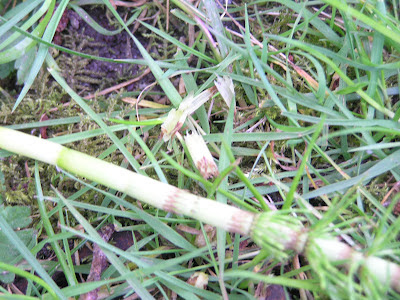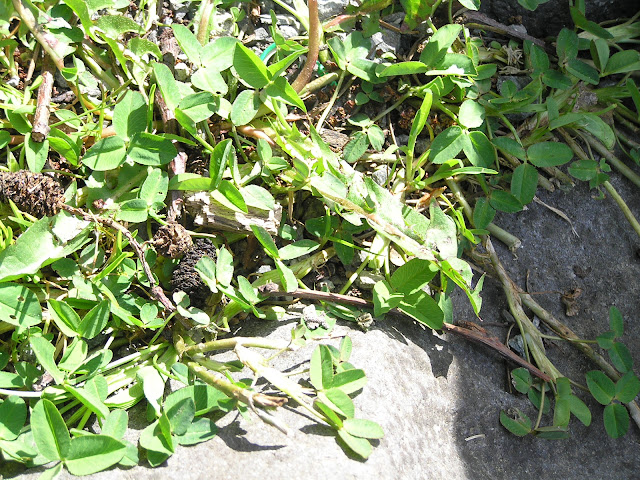Wild Foraging in April
Foraging
Health
Paleo
Raw
Remedies
Unschooling
Urban Farming
I just did my third Edible Weeds class with Melany Vorass through Sustainable Burien. There are still lots of greens to be foraged, though as many of them start to flower the leaves become a bit less palatable. While April is too early for berries around here, there were a surprising amount of edible plants that we found on our short walk at this urban park. Some of my photos didn't turn out so great, so please use this information in combination with Google or Wikipedia to find out how to more thoroughly identify these plants. Pfaf.org is another website where you can obtain info on plant edibility. Also, check out my previous post on edible foraging in February.
 |
| Melany demonstrates how to remove the "hula skirts" from horsetail stems. This papery layer must be removed from the stalks before they are safe to eat. Younger plants, before they branch out, contain less silica and are safer. |
|
 |
| A stalk of horsetail with a few "skirts" removed. |
|
 |
| Horsetail (Equisetum) also called "scourbrush", can be used to scrub dishes as well as burnish wood and polish metal. These plants are just a bit too mature to eat. The leaves around it are salmonberry, which can be eaten like spinach. |
|
|
 |
| Salmonberry (Rubus spectabilis) flowers, leaves, and berries are all delicious. |
 |
| Dandelions (Taraxacum) are edible in their entirety. The midrib of the leaves is a bit bitter and can be easily removed. Use the leaves in salads or smoothies, toss the flowers in salads or fritters, or make a batch of dandelion wine! The roots can be roasted and brewed like coffee. |
|
 |
| Bedstraw (Galium) is a bit bristly, but somehow succulent and tender at the same time. My kids call it "cat tongue" because of its scratchy surface, and they eat it straight out of the garden. I've used it in salads and smoothies. When it matures, you will find horrible bristly seeds stuck to your pants, socks, shoelaces, and to your cat. |
 |
| This is shotweed (Cardamine hirsuta). This is not a great photo of it, but most people would recognize it as the weed that shoots its seeds everywhere when you barely brush it with your hand. The leaves taste like watercress, but they diminish in size as the plant flowers and diverts its energy to making seeds. |
 |
| The young leaves of a maple tree (Acer) are such a treat! Just pick and eat, they are so good. Also, I recently read that any type of maple can be tapped for syrup. |
 |
| Poisonous: Buttercup (Ranunculus)... nothing about this plant is edible. I am in the process of removing it from the shady parts of my yard, where it has been taking over. |
 |
| Catsear (Hypochaeris radicata) flowers are similar to dandelion, but the stalk is solid, while the dandelion flower has a hollow stem, and of course the leaves are covered in fuzz, while dandelions have smooth leaves. They are also slower to to to seed than a dandelion. |
 |
| Nipplewort (Lapsana) has edible leaves. The leaves change shape dramatically as the plant forms its flower, going from this rounded heart shape to pointed spear shaped leaves on the flower stalk. |
 |
| Sow thistle (Sonchus) is a bit rough around the edges, but no real thorns. It has thick succulent, edible leaves. |
|
 |
| Full frontal shot of sow thistle. You can see some nearly mature shotweed seeds on the left, and some glossy beach strawberry (Fragaria chiloensis) leaves on the lower right. |
 |
| April is a bit late for harvesting rosehips (Rosa)... and this is a pretty lousy picture of them ;) Collect anytime after the first frost, and store in freezer for later use. Remove seeds through a strainer before using the fruit. Rosehips are super high in vitamin C. |
 |
| Pink and white clovers (Trifolium) are edible, both the flowers and leaves, raw or cooked. |
 |
| Fireweed (Epilobium angustifolium) makes a delicious, tender salad green. |
 |
| Dock (Rumex crispus) leaves, and their seeds later in summer, are edible. The seeds can be used in baking to replace up to 1/4 of whatever grains you're using. The have a husk which is a bit tough and impossible to remove, but it incorporates fine into bread or crackers. New leaves, still tightly curled inside a sheath, can be used like asparagus after removing their sheath. My rabbits devour this nutritious plant. |
|
 |
| Don't eat this plant. Common Groundsel (Senecio vulgaris) is reported to be both toxic and medicinal. |
 |
And of course, our favorite this year, stinging nettles (Urtica dioica). We've been living off these lovely leaves for months, in our green smoothies, and in the winter we enjoy them in an infusion. They are delicious and tender, once you get past that pesky sting (click here for my smoothie recipe and here for the nettle tea).
I'm linking an Amazon ad below to Melany's book on eating weeds. If you use my ad link to make a purchase, it benefits our family as well as the author. Thanks in advance! |
Share the article to support the site!
Wild Foraging in April
4/
5
Oleh
Mellow
Subscribe via email
Get up to date articles the second they come out!


























41 comments
Write commentsCan you eat catsear like dandelions? My garden has been full of shotweed ghis spring. It's interesting how the weeds rotate-- one year is all purple dead-nettle, the next, shotweed-- but the buttercup never goes away. I love my nettle soup this time of year.
ReplyThat was me, btw-- Melissa K.
ReplyHey Melissa, try raw catsear in salads, or sauteed with butter & garlic. I use pretty much any greens in my green smoothies as well.
ReplyThanks for this great blog piece. I love the pictures and links.
ReplyGreat description of our foraging that day, and much more descriptive than my write-up, complete with latin names!
ReplyOoh, where can I find yours? I'd love to read it.
ReplyVery informative! Thank you for sharing your experience. I'd love to have a class like this in my area!
ReplyThis class looks great...I'm having nettle soup for lunch made with foraged nettles from the woods at the end of the garden. I don't so much mind the tingling...then I'm sure that I've collected the right leaves and not something poisenous!!
ReplyDeb
Wow, what an informative post. We have been foraging in our yard for dandelions this spring for the first time. I love it!
ReplyThe stinging doesn't really bother me, either, but I think it's worse when you get a large area of sensitive skin. It just feels tingly on my hands. Maybe we're less sensitive to it than some people? Yum, I wish I had nettles in the woods at the edge of my garden, instead of just neighbors' houses ;)
ReplyThanks for all this information in one post! I've shared it on my facebook page. I had no idea that salmonberries, flower, and leaves were edible, and I have never thought about eating clover. Who needs lettuce when you can forage for greens in your own neighbourhood!
ReplyI know! We've stopped buying greens these days, with so much we can just go out and harvest.
ReplyThis is a great post. I wish I could find a class like that here! I sure never would have thought of eating what we call "sticky weed"!
ReplyTerrific post! Thanks for sharing so much good information along with pictures to identify each plant.
ReplyThanks you guys! Yes, it is a great class and I feel lucky to have such a generous & knowledgeable teacher.
ReplyGret information! Looks like you had a great time.
ReplyVery interesting! Thanks for sharing!
ReplyI loved this. Thanks for linking to Your Green Resource. I featured it and pinned it.
ReplyWhat a great resource of information. I know my readers will be so happy to have found this. Thanks for sharing it with us at Whole Food Wednesdays. http://www.beyondthepeel.net/2012/06/mostimportanttoremember.html
ReplyHow fun to take a class like that. You learned a lot!
ReplyI'll have to try some Dandelions.
Replyhttp://theapels.blogspot.com/2012/07/digging-potatoes.html
Oh this is so interesting, but I wouldn't be brave enough to eat these as I'm allergic to so many things. Thank you for sharing!
ReplyWhat an informative post...........Thanks for linking it up @ CountryMommaCooks link and greet party.....hope to see you again tomorrow : )
ReplySomeone at my co-op was just telling me about a foraging class in our area. I am going to look this up because I definitely don't trust myself to figure this stuff out on my own. :) Great post. I think I saw this before but sometimes I think I need a reminder. :)
ReplyI took a couple of foraging classes before I felt comfortable, and confident, foraging for more than berries. But over time, learning this stuff has totally transformed the way we eat! Good luck!
ReplyWhat an interesting post! I have never been foraging, but I know that more and more people are enjoying it!
ReplyVery cool to learn about this!! I tweeted and pinned this post!!
ReplyWhat a great post! I shared on my facebook page.
ReplyThanks Linda!
ReplyI'm so interested in foraging, but nervous about plant identification. While people have been foraging for a long time, region specific information can be difficult to find. Thanks for posting this - I do see a lot of overlap between our plants.
ReplyThere are some great books that will have region-specific plant information. Check your library to see what foraging or plant id books they have; there are new ones coming out all the time, and some are really helpful!
ReplyI'm so glad you've been sharing these posts on foraging, you've actually inspired me to take a class on foraging at my local co-op :) I've pinned this on the Waste Not Want Not Wednesday board, too.
ReplyThat's so great! Thanks for letting me know. Early spring is a great time to get into wild foraging.
ReplyVery interesting! Thanks for sharing this at my Pin Me Party!
ReplyGreat photos. Thanks for sharing at Wildcrafting Wed.
ReplyJennifer
Congrats on your feature on Wildcrafting Wednesday! Great info! I'm sharing this :)
ReplyLots of very good information here. I actually think your pictures are great! It is so important to learn what is safe to eat and what is not. I agree, especially if you have children or grandchildren, that poisonous plants shouldn't be allowed to grow near a possible harvesting area on your own property. Of course, out in the wild that's another story! Around here there is a lot of wild mustard growing in the orchards and I see a lot of people harvesting it. Perhaps I should try harvesting these edible plants also! Thanks for sharing!
ReplyI love nettle tea! Had my first cup last year! So much great info here...I will be back!
ReplyLinda
mysewwhatblog
This is fascinating. I'd love to learn more about this, and maybe find some benefit to the weeds in my backyard.
ReplyHope you have a wonderful week end and thank you so much for sharing with Full Plate Thursday.
ReplyCome Back Soon!
Miz Helen
Such wonderful photos, pretty and informative! It looks like your class was great.
ReplyThanks for sharing on Natural Living Monday!